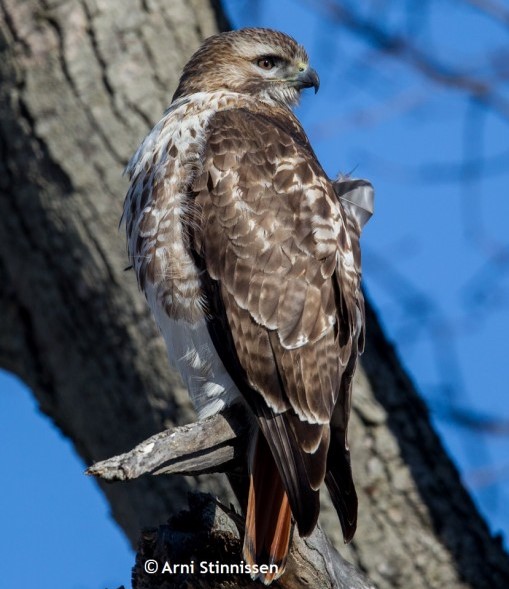We all have people we see frequently as they pass by in the snowplough, delivery van, or car. Others we pass on the street or in the grocery store. Many of these people we really don’t know at all, but nevertheless, we acknowledge each other with a wave, a smile or even a hello! We frequently don’t know their names and very little, if anything about them. Many of us consider these people “friends”.
These casual encounters may be with individuals other than people as well.
We have two such friends. We see them every trip to town, sitting on a utility pole or in a nearby maple tree. These friends happen to be a pair of Red-tailed hawks. Every time we see them, we acknowledge them and I feel quite sure they recognize our vehicle as it passes below them.
Red-tailed hawks are the most easily recognizable hawks we have. They are rather large, with stocky bodies and broad, rounded wings. They normally have brownish streaks on their white breasts, but their most distinguishing identifier is a short, wide and wonderful russet coloured tail. They are most often seen perching on utility poles or in trees as they search their territory for prey usually consisting of mice, voles, small birds and even squirrels and rabbits. They swoop down from their perch to grasp the prey in their talons, taking the small catch back to their perch to eat. Larger prey is eaten on the ground. If hunting from the perch is not paying off, they will soar above the open fields searching.
Those that overwinter here will begin to engage in aerial courtship activities in February. They will soar and circle each other, males will dive toward the ground uttering raspy screams before ascending back up above the female.
Many Red-tailed hawks residing in our area remain with us year round, others will migrate short distances into the U.S. Those that overwinter here will begin to engage in aerial courtship activities in February. They will soar and circle each other, males will dive toward the ground uttering raspy screams before ascending back up above the female. At other times, the male will extend his legs and talons and tap her on the back. Sometime they will clasp each other’s talons and tumble, plummeting towards the ground before letting go and then they rise back to the higher elevations. It is a wonderful performance to sit and watch.
A pair will typically mate for life. Both will engage in the nest building, constructing it of sticks high in a nearby large tree. The considerable nests are easily spotted before the leaves emerge. Two to three eggs are laid most often during March, but some pairs may not get down to family making until later in the spring. Both parents will take turns incubating the eggs which hatch in about 30 days. When the eggs hatch, the male provides all of the food, bringing it to the nest where the female will tear it into bite sized pieces for the chicks. The chicks will fledge in about 6 weeks, but will stay close by the parents for 6-8 weeks.
The Red-tailed hawk courtship season is upon us. Do yourself a favour, get that warm coat on, find a quite road with open fields in the country and watch the performance! Make yourself some new friends!
Written by David A. Homer.

